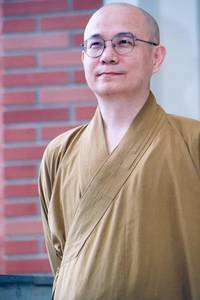Abstract: A Inquiry Concerning the Lineage of Bhikkhuni Ordination
by Bhiksu Huimin Shih
Professor, Taipei National University of the Arts
President, Dharma Drum Buddhist College
1. Bhiksuni ordination by the bhiksuni sangha alone, or by both the bhiksu and bhiksuni sanghas
The bhiksu ordination originates with the Buddha. This rite evolved from the Buddha's exhortation to "Come hither, bhiksu" and the triple refuge, to the later form of the "karman by threefold assent." The bhiksuni ordination is fundamentally completed by the bhiksu sangha. Ordination by the bhiksuni sangha alone may be regarded as a preliminary preparation. We may look at the bhiksuni ordination in China and India from a historical perspective. Indian Vinaya master Gunavarman states, "Bhiksunis are ordained by the bhiksu sangha. Ordination by the bhiksuni sangha is to be taken as a preliminary measure." In China, Vinaya master Daoxuan of the Tang dynasty concludes, "The Vinaya-pitaka does not explicitly state that 'failure to perform the benfa (preliminary ordination by only the bhiksuni sangha) invalidates the ordination.'" This is reasonable. During the time of the Buddha, the transmission of the bhiksuni sangha was never broken. As a result, it is impossible to find any records about the preliminary bhiksuni ordination by the bhiksuni sangha alone.
2. Siksamana and sramanerika ordinations
Due to the background of Rahula's ordination, the Buddha required that prior to full bhiksu ordination, male candidates must first take the sramanera ordination. According to the Vinaya, before receiving the full bhiksuni ordination, female candidates must also take the sramanerika ordination. The siksamana precepts are due to the possibility of pregnancy in female candidates. This training period lasts two years to ensure that the female candidate is not pregnant. Also, this time is used for training in the six dharmas (part of the bhiksuni Vinaya), and for evaluation of the candidate's suitability for full ordination. In the Sri Lankan Buddhist chronicles, there are records of sramanerika and bhiksuni ordinations, but no records of siksamana ordination. It is clear that for some early sanghas, there may have been instances of local adaptations.
According to the Mulasarvastivada and Dharmaguptaka Vinayas, the bhiksuni ordination must be preceded by the sramanerika and siksamana ordinations respectively (the ordination is first done in the bhiksuni sangha, and then in the bhiksu sangha).
3. Preceptors, time, location, and procedures for the bhiksuni ordination
Typically, the sramanerika, siksamana, and preliminary bhiksuni ordinations are all performed by the bhiksuni sangha. However, according, to Sri Lankan Buddhist chronicles, there seem to be records of bhiksus performing the sramanerika ordination.
The Chinese version of the Mulasarvastivada Vinaya provides guidance on full ordination: a comparatively simple procedure, the preliminary ordination by the bhiksuni sangha, a "karman by one assent," is performed in the presence of twelve bhiksunis with over twelve years in the sangha. Subsequently, the bhiksuni sangha invites ten bhiksus with over ten years in the sangha to the ordination platform to perform the full ordination with the more complex "karman by threefold assent." According to the Dharmaguptaka Vinaya, both two procedures need ten preceptors, both two procedures need "karman by threefold assent," and the bhiksunis bring the candidates for ordination to the bhiksu sangha to receive full ordination by the karman of threefold assent.
Buddhismus (Foundation for Buddhist Studies) and
takes place in co-operation with the
Asia-Africa-Institute of the University of Hamburg.
See our list of sponsors.

